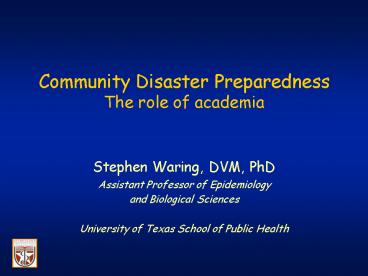Community Disaster Preparedness The role of academia - PowerPoint PPT Presentation
1 / 24
Title: Community Disaster Preparedness The role of academia
1
Community Disaster PreparednessThe role of
academia
- Stephen Waring, DVM, PhD
- Assistant Professor of Epidemiology
- and Biological Sciences
- University of Texas School of Public Health
2
- All our science, measured against reality, is
primitive and childlike, yet it is the most
precious thing we have. - Albert Einstein
3
Filling in the gaps Preparedness versus current
readiness
- Natural disasters
- Storm related
- Flood
- Tornado
- Hurricane
- Blizzard
- Ice storm
- Mudslides
- Earthquakes
- Drought/heat wave
- Wildfires
4
Filling in the gapsPreparedness versus current
readiness
- Man-made disasters
- Weapons of mass destruction
- Biological
- Chemical
- Radiological/nuclear
- Explosives
- Accidents
- Chemical plant explosion
- Transport (train, truck) wreck
5
Filling in the gapsPreparedness versus current
readiness
- Terrorism
- Bioterrorism
- Agroterrorism
- Cyberterrorism
6
Filling in the gapsPreparedness versus current
readiness
- Domestic preparedness program
- Reduce vulnerability by widespread improvement of
response capability - Requires cooperation
- Interagency
- Interjurisdictional
- Interorganizational
7
Filling in the gapsState and local agencies
- Operational systems
- Law enforcement
- Fire department
- HAZMAT
- EMS
- Emergency management
- Public Health infrastructure
8
Filling in the gapsAcademic institutions
- Teaching/training skills
- Research skills
- State of the art knowledge
- Study design and implementation
- Survey methodology
- Rigorous/systematic data collection
- Data management/analysis
- Program evaluation
- Service related network
9
Disaster PreparednessStakeholders
- Inter- and intra-agency
- Federal, state, local
- Government and non-government
- ..whos on first??
10
Disaster PreparednessKey Features
- Communication
- Coordination
- Allocation
11
Disaster PreparednessComprehensive strategy at
local level
- Assessment of threat
- Awareness
- Reality
- Spectrum
From Perspectives on Preparedness, November 2001,
No. 5
12
Disaster PreparednessComprehensive strategy at
local level
- Preparation to meet threat
- Establish adequate level of preparedness
- Develop emergency plans for all hazards
- Acquisition of requisite equipment
- Sustainability training, maintenance
13
Disaster PreparednessComprehensive strategy at
local level
- Training and practice
- Educate
- First responders
- Public officials
- General public
- Practice execution of plans
14
Disaster PreparednessComprehensive strategy at
local level
- Coordination of key resources
- High-level coordinating role of leaders
- Promote interagency coordination
- Communication with policymakers, advisors, public
- Facilitate intelligence sharing
- Maximize use of federal resources
15
Disaster PreparednessPriorities for change at
local level
- Medical and Public Health
- Improve public health monitoring and surveillance
systems - Expand medical surge capacity
- Evaluate available pharmaceuticals
16
Disaster PreparednessPriorities for change at
local level
- Communication
- Improve communication systems
- Mandate interoperable communications
- Develop a public affairs plan
17
Disaster PreparednessPriorities for change at
local level
- Cross-jurisdictional and cross-professional
coordination - Promote adoption of IMS
- Fortify mutual aid agreements
18
Disaster PreparednessPriorities for change at
local level
- Contingency planning
- Build and maintain backup of critical resources
- Equipment, communications, record keeping,
personnel not in same location - Establish comprehensive legal framework for law
enforcement, etc. - Implement training standards for skills specific
to disaster response
19
National Bioterrorism Preparedness and Response
Initiative Key features
- Preparedness and prevention
- Surveillance and surveillance
- Diagnosis and characterization of chemical and
biological agents - Response
- Communication systems
20
National Bioterrorism Preparedness and Response
Initiative Partners
- Government
- Department of Justice (NDPO, FBI, ODP)
- USDA
- DHHS/Office of Emergency Preparedness (OEP)
- Department of Defense
- Department of Veterans Affairs
- Food and Drug Administration
- Department of Energy
- Environmental Protection Agency
- Federal Emergency Management Agency
- The National Security Council
- Department of State
21
National Bioterrorism Preparedness and Response
Initiative Partners
- Non-government
- Association of State and Territorial Health
Officials (ASTHO) - National Association of County and City Health
Officials (NACCHO) - National Association of Local Boards of Health
(NALBOH) - American Public Health Association (APHA)
- Association of Public Health Laboratories (APHL)
- American Society of Microbiology (ASM)
- National Registry of Emergency Medical
Technicians (NREMT) - National Environmental Health Association (NEHA)
22
National Bioterrorism Preparedness and Response
Initiative Partners
- Non-government (contd)
- American College of Emergency Physicians (ACEP)
- National Governors Association (NGA)
- Council of State and Territorial Epidemiologists
(CSTE) - American Nurses Association (ANA)
- National Emergency Management Association (NEMA)
- American Medical Association (AMA)
- American Hospital Association (AHA)
- International Association of Fire Chiefs (IAFC)
- International Association of Police Chiefs (IAPC)
- Association of Schools of Public Health (ASPH)
- Association of Teachers of Preventive
Medicine(ATPM) - American Veterinary Medical Association (AVMA)
23
BT Preparedness Response Program
NCID Labs Research Surveillance Bioterrorism
Response
NCEH Stockpile Chem/Rad Response Planning
BPRP Coordination Communication Accountability
Emergency Response Policy Development
PHPPO Health Alert Network Training Technical
Support
EPO Epi/Surveillance Detection Investigation
Communications
OHS Lab Safety Administer Select Agent Rule
ATSDR NIP NIOSH NCIPC
24
Incident Management Systems































